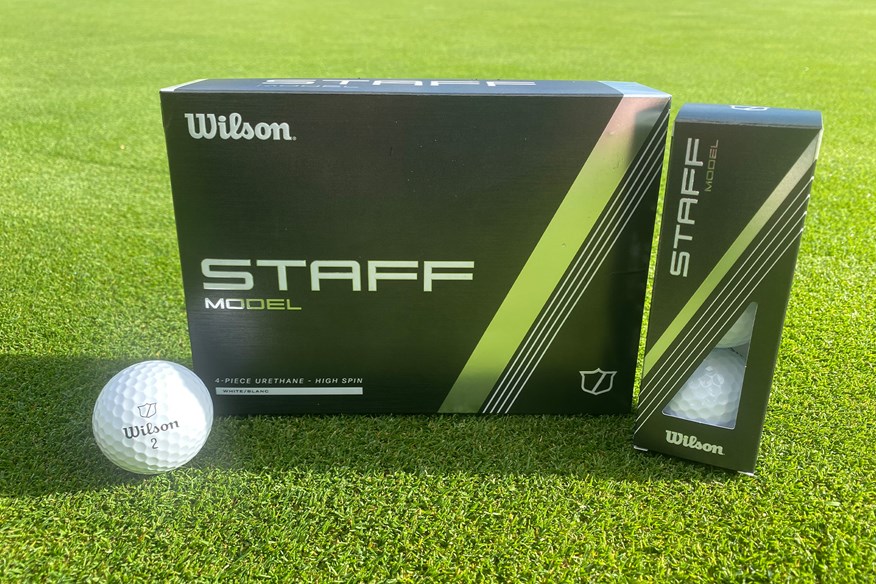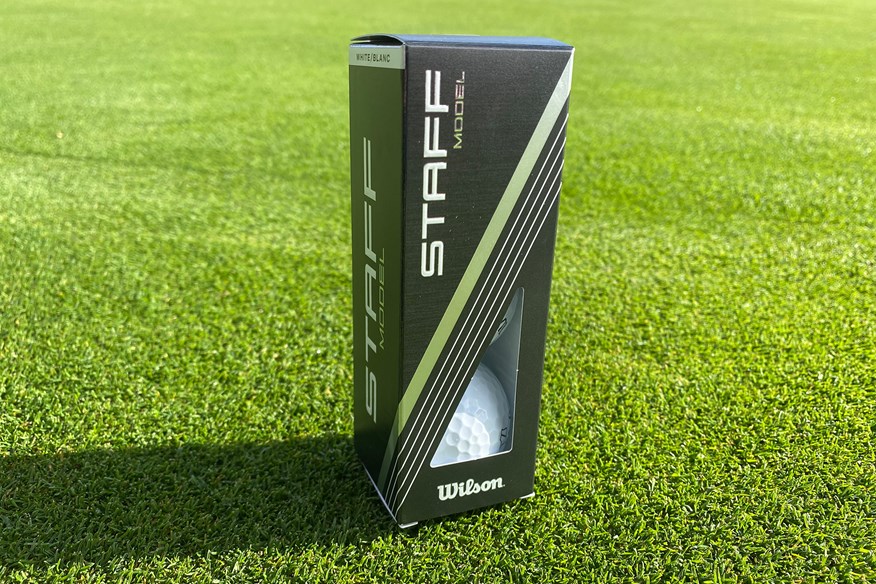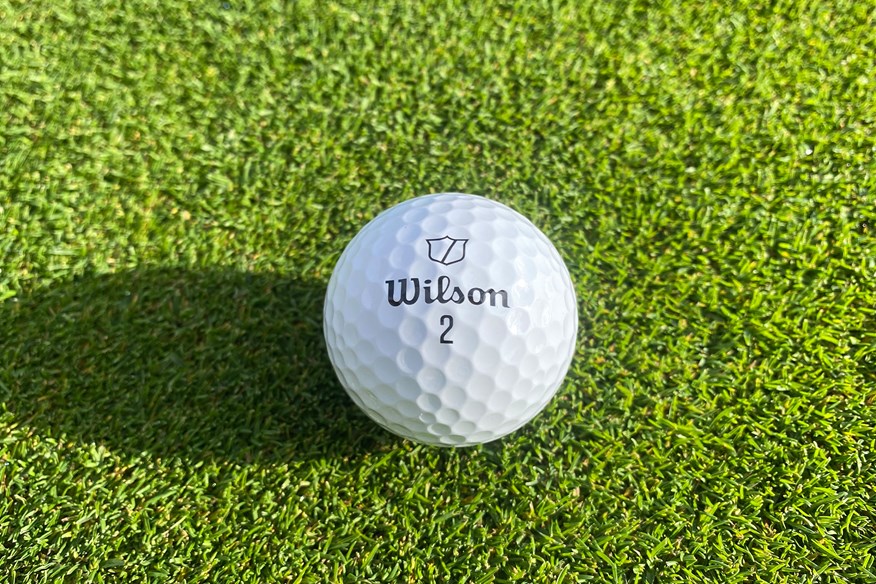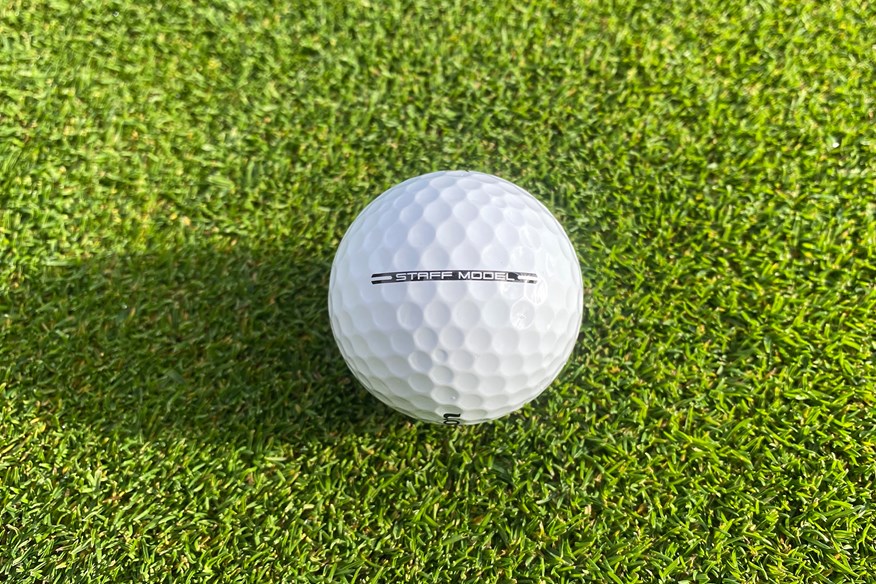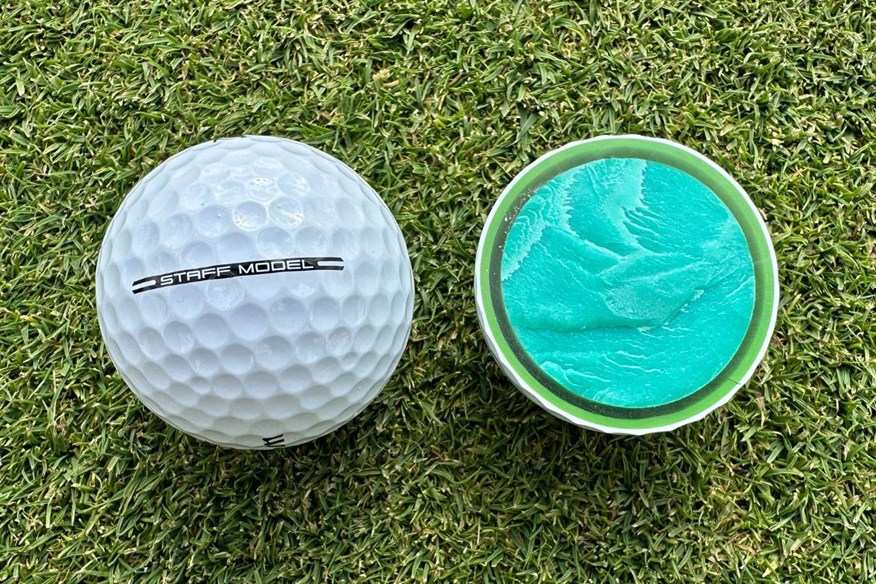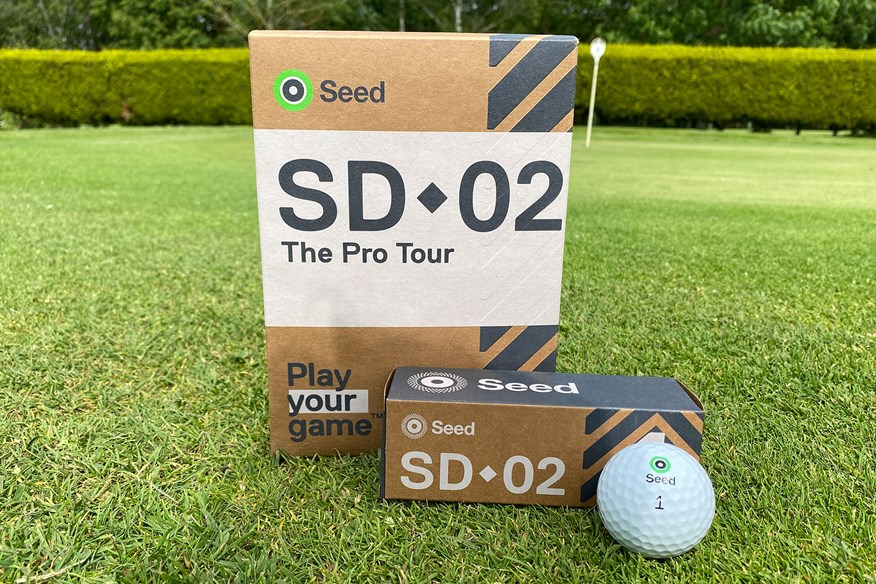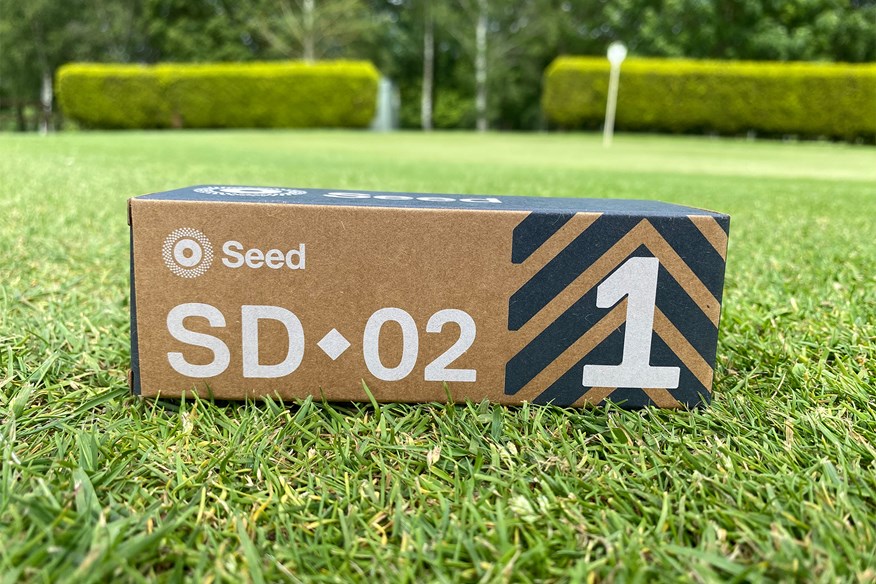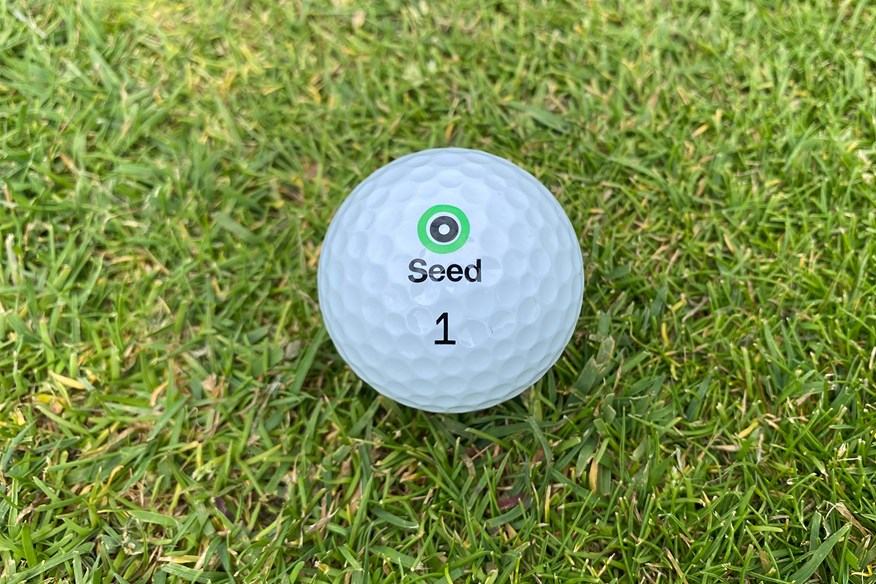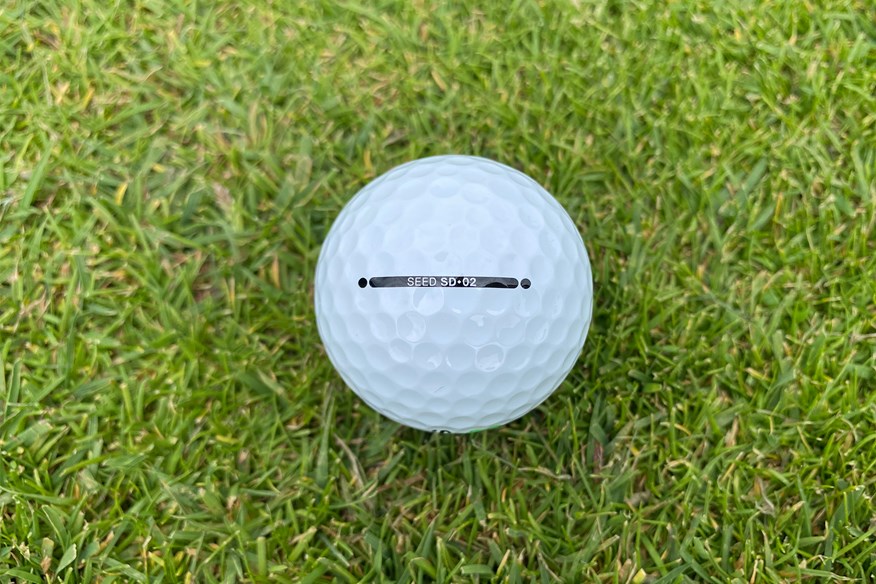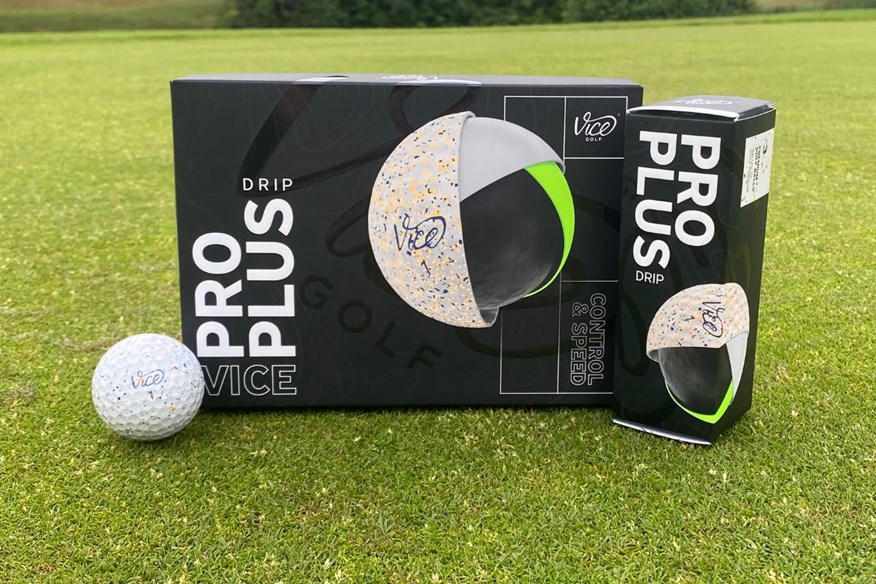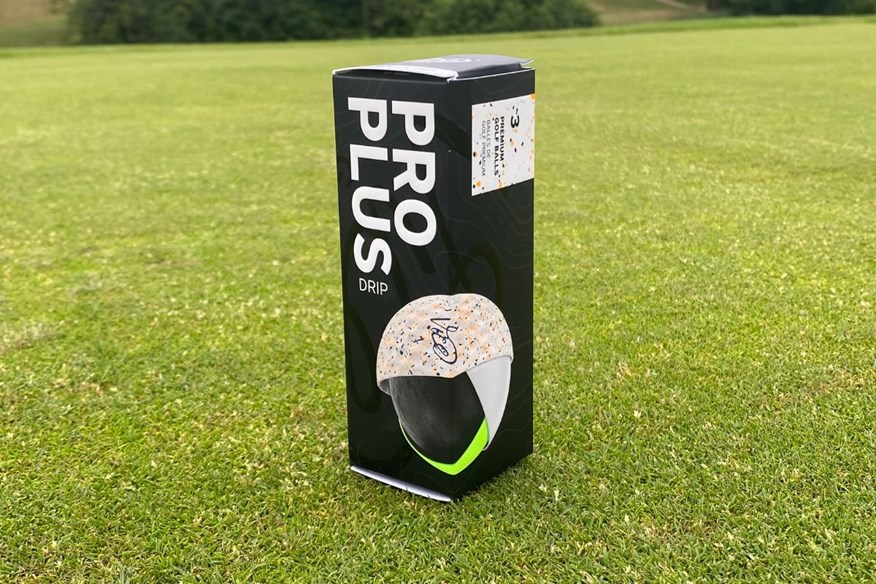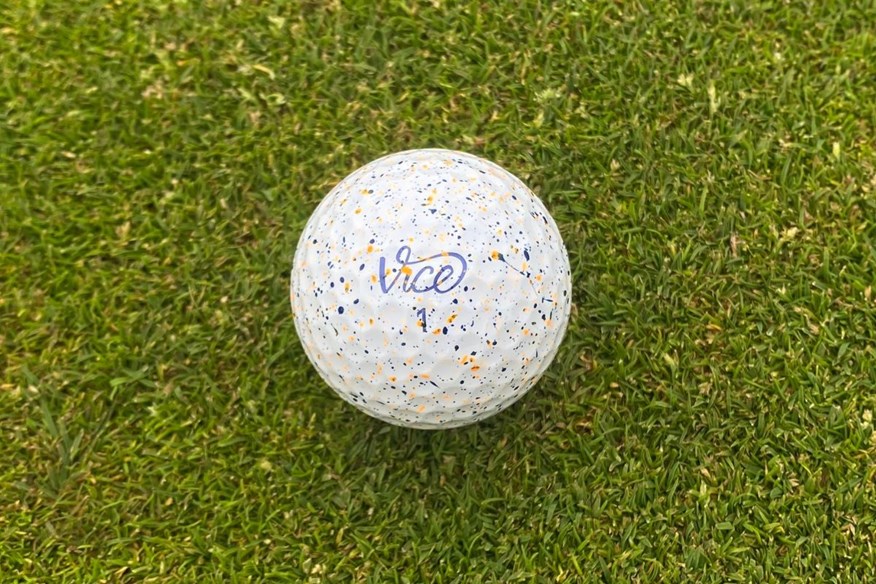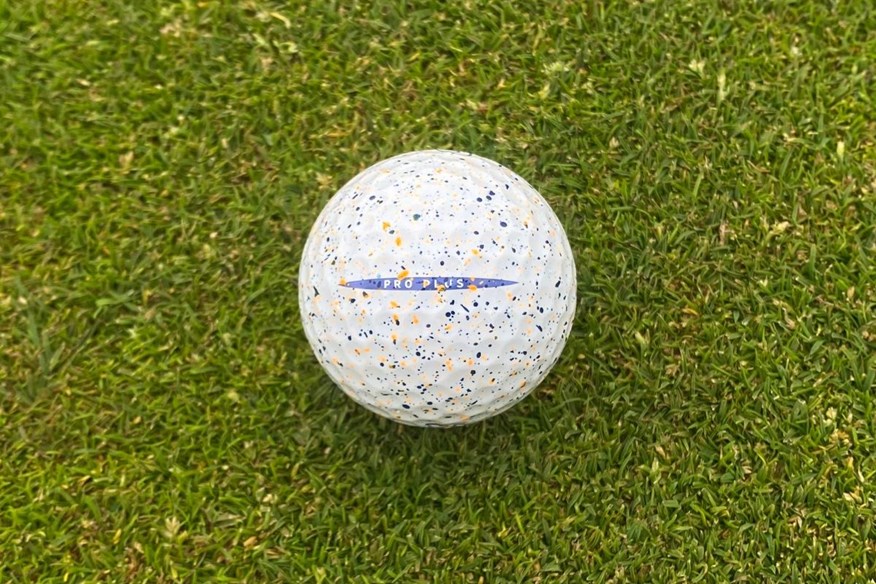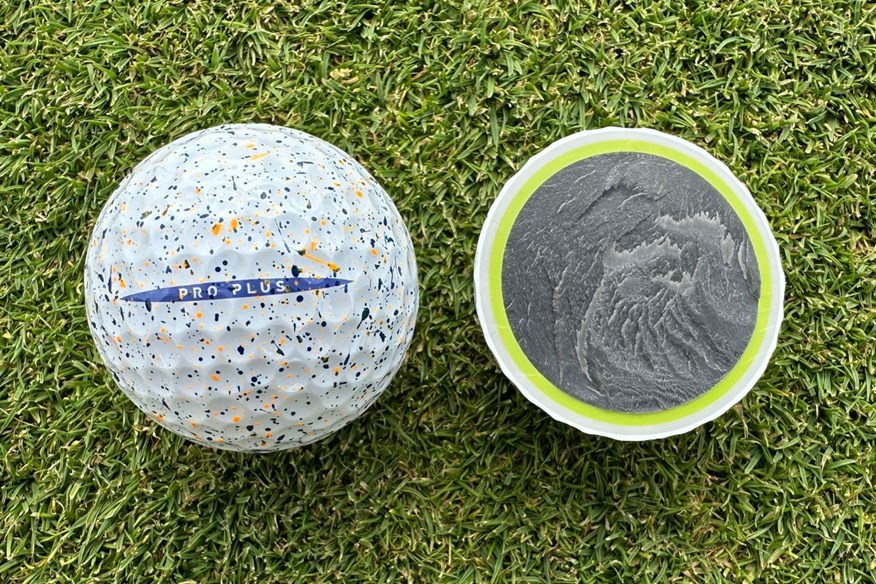Best golf balls for average swing speeds 2025: Tested on a robot and on-course for precise results
Last updated:
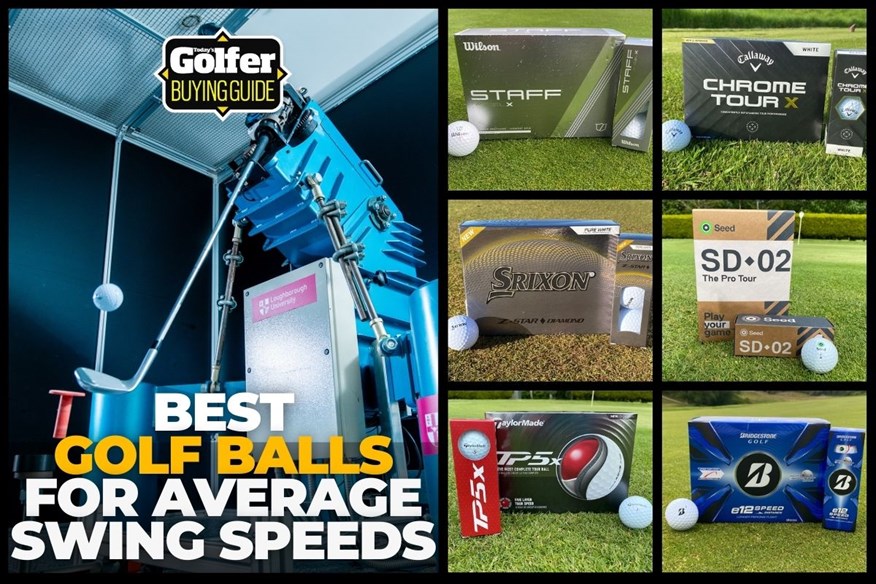
Click here to find out how we conducted our 2025 golf balls test
We’ve tested the most popular and most-played golf balls for average swing speed golfers with both an R&D robot as well as on-course, to help you determine which is the best golf ball for your game
Jump to:
- At a glance
- Best golf balls for average swing speeds
- Robot test data
- Buying guide
- FAQs
- What to read next
If you possess a moderate swing speed and are seeking the best golf ball for your game, you have come to the right place. We’ve put 62 golf balls through their paces with advanced robotic testing and compiled a selection that we can recommend to golfers across a wide range of abilities.
An average swing speed does not mean you can’t play with premium golf balls, nor does it mean you have to use a distance golf ball. Premium models remain very much within reach. However, for those who would prefer options more closely aligned with their current level of play, we also provide detailed recommendations on the best golf balls for mid-handicappers as well as the best golf balls for beginners and high-handicappers.
Best two-piece golf balls: At a glance
The golf balls highlighted in this guide include both Tour-level models and the best value golf balls, reflecting the variety available to players with average swing speeds. While the products featured here offer an excellent foundation, there are many alternatives worth exploring.
If, after reviewing our recommendations, you’re still uncertain about the right choice of golf ball for your game, we encourage you to read our comprehensive buying guide and FAQ section, where additional insights are provided.
- 2025 golf ball robot test: 62 golf balls, 2,232 shots, 50,000 data points… find out what’s No.1 for you
- How we test golf equipment at Today’s Golfer
The main aspect to consider when looking for the best golf ball if you have an average swing speed is… you’ve guessed it… swing speed! If you have a swing speed below 85mph, chances are you would benefit from playing with a ball for slow swing speeds. If you have a swing speed above 105mph, you’d be better placed to look at the best golf balls for fast swing speeds.
The other is ability. As I’ve already mentioned, there is a wide range of golf balls featured below, from five-piece golf balls to two-piece golf balls. Based on your ability, you should find a suitable option to help you play great golf.
Best golf balls for average swing speeds 2025
The most dominant Tour-level golf ball
Best overall golf ball for average swing speeds
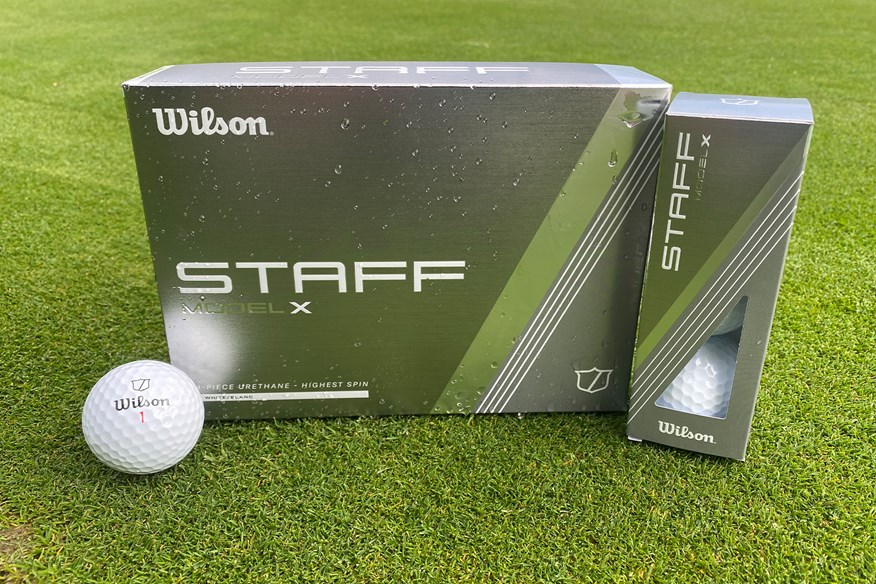

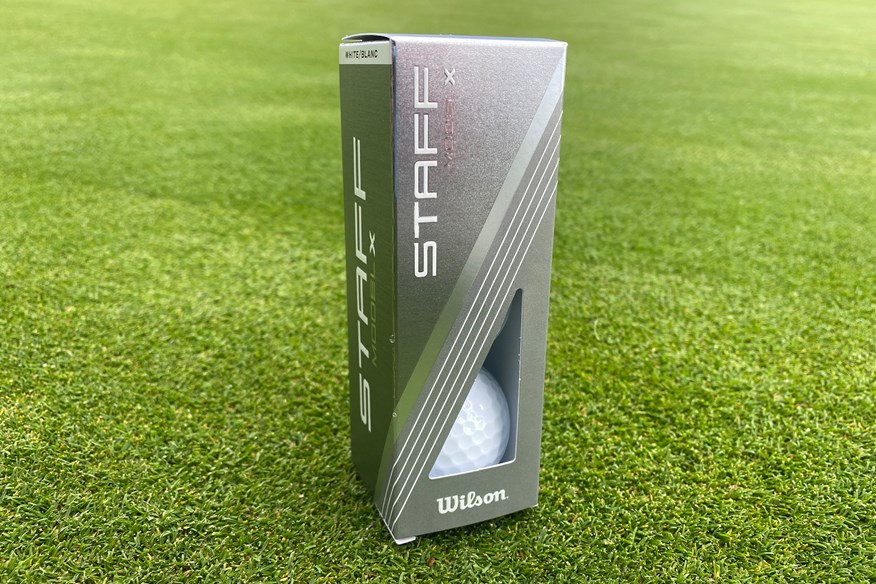
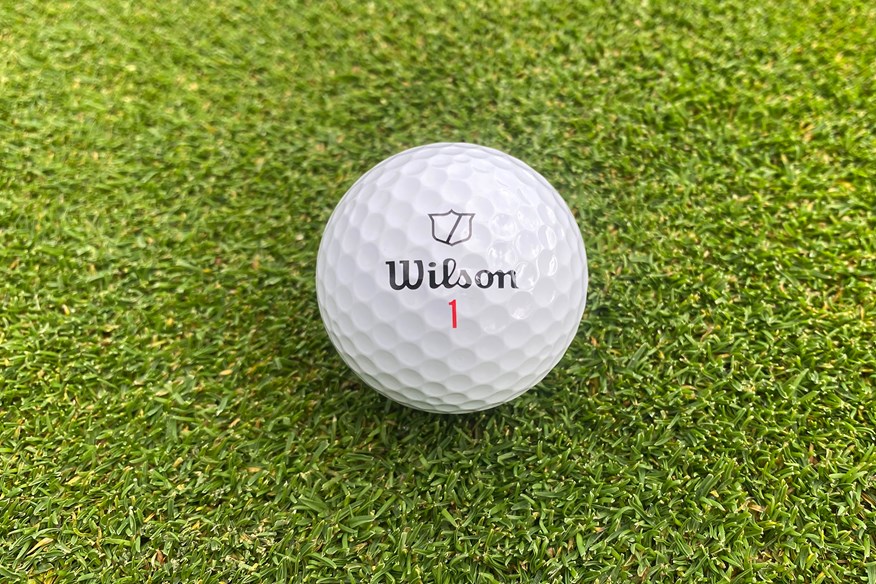
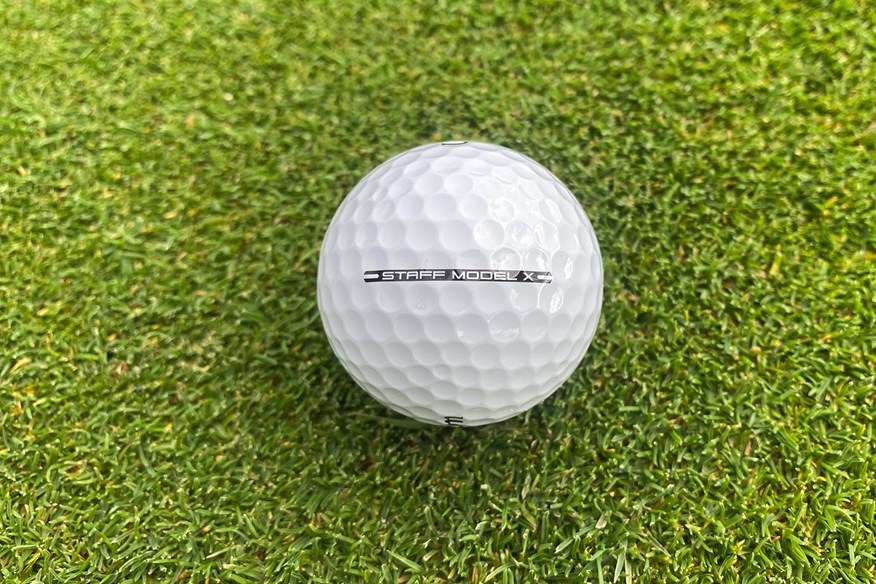

This is arguably the best golf ball in the game. The Wilson Staff Model X is the golf medal winner for tee to green performance at 93mph and 78mph, silver medal winner for tee to green performance at 114mph, silver medal winner for off-the-tee performance, and bronze medal winner for approach play and short game spin.
No other golf ball in our test has received as many awards as the Staff Model X. It's the only golf ball to have received an award in every category.
Staff Model X isn't the longest or fastest golf ball at any of the three driver swing speeds we tested, but it's consistently towards the top of the rankings. It's a higher-spinning golf ball compared to the Staff Model, and that is highlighted with its approach play and short game performance.
This golf ball lands with the steepest descent angle of all 62 tested (45.4°), which helps it easily hit and hold greens. Pair that with the fourth-highest backspin (4,782rpm) and you have a recipe for success.
With the 40-yard pitch shot, Staff Model X generated the third-highest spin (6,091) and again, a steep descent angle (35.5°), meaning this golf ball will stop very quickly when playing around the greens.
On-course verdict
Since being released at the start of 2024, the Staff Model X has been one of my favourite golf balls to play with over the past couple of years. I have a ton of confidence in this model whenever I put it in play. It has become a go-to golf ball for me when I'm not playing my best golf because I know I can trust it to perform well and true.
With its firm feel, it may not appeal to every golfer, but this makes the ball extremely responsive, providing brilliant feedback on all shots. The firm feel is noticeable, compared to softer golf balls, but after a couple of rounds, you practically forget it's a firm golf ball.
Off the tee, the Staff Model X offers slightly more spin than the Staff Model, but that doesn't hinder its overall carry distance. The higher-spinning nature of this model means greenside spin and control is very strong.
The Wilson Staff Model X is the full package. If you're shopping for a premium Tour-level golf ball, this is the No.1 option for golfers of all abilities to consider.
Read our full Wilson Staff Model X golf ball review.
Pros
- Extremely responsive thanks to the firm-feeling
- Performs highly for golfers of all abilities
- Amazing short-game spin and control
Cons
- Higher-spinning than the Staff Model off the tee
| Carry distance (yds) | Driver 114mph - 273.7 | Driver 93mph - 209.8 | Driver 78mph - 162.2 | 7-iron - 156.1 |
| Ball speed (mph) | Driver 114mph - 164.3 | Driver 93mph - 134.6 | Driver 78mph - 113.4 | 7-iron - 109.3 |
| Backspin (rpm) | Driver 114mph - 2,797 | Driver 93mph - 2,792 | Driver 78mph - 2,623 | 7-iron - 4,782 | Pitch - 6,091 |
| Launch angle (°) | Driver 114mph - 11.2 | Driver 93mph - 12.5 | Driver 78mph - 13.8 | 7-iron - 21 | Pitch - 30.4 |
| Descent angle (°) | Driver 114mph - 38.4 | Driver 93mph - 32.6 | Driver 78mph - 28.1 | 7-iron - 45.4 | Pitch - 35.5 |
| Peak height (yds) | Driver 114mph - 33.7 | Driver 93mph - 22.6 | Driver 78mph - 15.9 | 7-iron - 30 | Pitch - 6.7 |
| Compression (psi) | 114 |
- V-Cor advanced performance
- Firm compression core with velocity-boosting additive
- 3SIX2 seamless urethane cover
- 362 dimples
- 4-Piece construction
- Available in white and yellow
Golf medal for approach play and short game performance
Best Callaway golf ball for average swing speeds


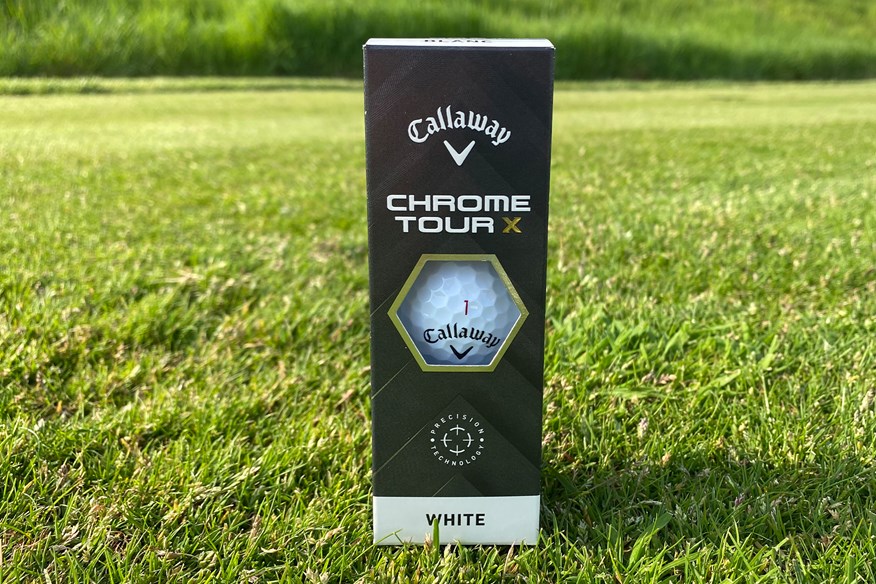

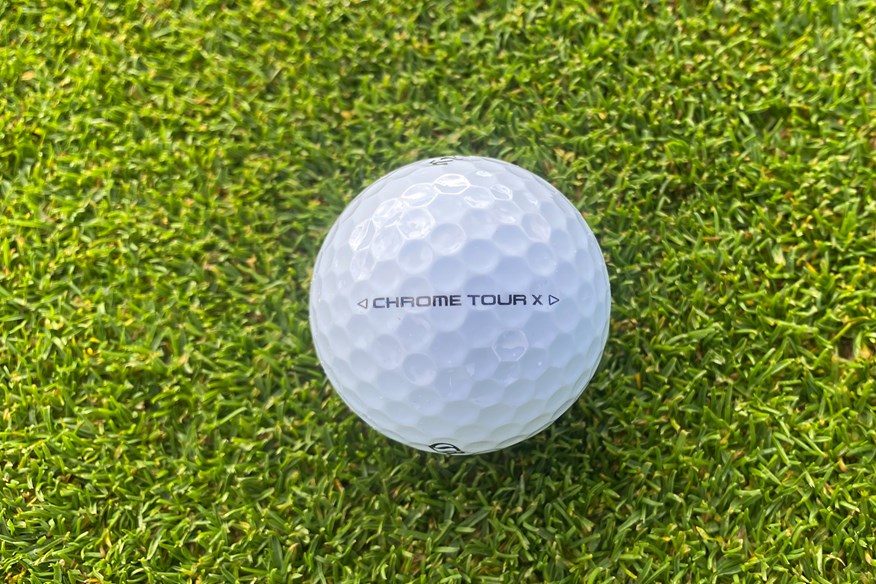
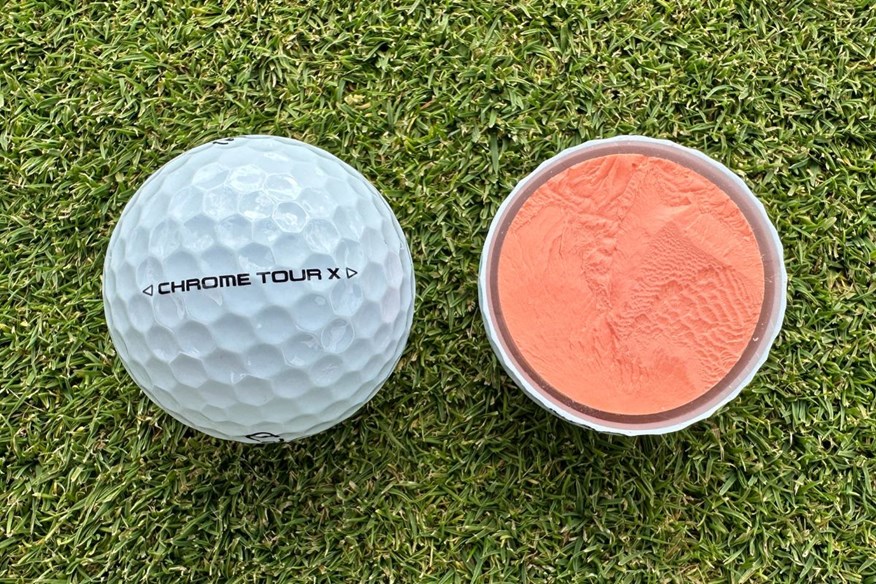
Every golfer wants a golf ball that stops on a dime when playing around the greens because it makes getting up and down so much easier. The golf ball that's going to help you out most around the greens is the Callaway Chrome Tour X.
Of all 62 golf balls tested, the Chrome Tour X is the highest-spinning golf ball around the green. This golf ball was able to generate 6,343rpm, the nearest in this category is the TaylorMade TP5 (6,100), and the second-highest spinning in the test is the Srixon Z-Star Diamond (6,137).
The high-spin nature of the Chrome Tour X does continue through the bag, which isn't an issue when approaching greens. As well as being awarded the gold medal for short game performance, the Chrome Tour X also finished first for approach play.
With the 7-iron shot, this is the highest-spinning golf ball in the test with 5,242rpm. Over 400 revs higher than the second-highest-spinning golf ball in this category (TaylorMade TP5 - 4,823).
The only issue with such a high-spinning golf ball is it hinders distance, so if you prioritise distance over spin, the Chrome Tour is a better option. However, if you want more control and spin, the Chrome Tour X has to be at the top of your list.
Off the tee, you aren't losing much distance with the Chrome Tour X, and at 93mph, this is the second-best four-piece and five-piece golf ball from tee to green.
On-course verdict
Callaway have absolutely smashed it out of the park this year with their four-piece Chrome Tour, Chrome Tour X, and Chrome Tour Triple Diamond golf balls.
Other than having major shelf appeal, the Chrome Tour X is premium for multiple reasons. One of which is that it's widely used by Tour players, and another is that it's a really solid performer from tee to green.
Off the tee, the Chrome Tour X is the highest-spinning Chrome Tour model, which won’t be to everyone’s liking, but for those who struggle to generate height and potentially lose the ball left, then the Chrome Tour X is well worth considering.
The Chrome Tour X spins on command. Playing into and around greens is extremely fun and simple because you can throw this ball at the pin and it will stop.
If you want a golf ball that spins high and is easy to control, there isn't a better option out there.
Read our full Callaway Chrome Tour X golf ball review.
Pros
- Extremely high spin and control when approaching the greens
- Produces brilliant ball speeds and distance
- Played by some of the best players in the world across numerous Tours
Cons
- Callaway's highest-spinning premium golf ball might not be what every golfer needs
| Carry distance (yds) | Driver 114mph - 269.7 | Driver 93mph - 208.9 | Driver 78mph - 160.8 | 7-iron - 156.1 |
| Ball speed (mph) | Driver 114mph - 163.6 | Driver 93mph - 134.3 | Driver 78mph - 113 | 7-iron - 108.7 |
| Backspin (rpm) | Driver 114mph - 2,997 | Driver 93mph - 3,048 | Driver 78mph - 2,921 | 7-iron - 5,242 | Pitch - 6,343 |
| Launch angle (°) | Driver 114mph - 10.8 | Driver 93mph - 12.5 | Driver 78mph - 13.5 | 7-iron - 20.3 | Pitch - 29.5 |
| Descent angle (°) | Driver 114mph - 38.7 | Driver 93mph - 34 | Driver 78mph - 28.8 | 7-iron - 45.3 | Pitch - 34.4 |
| Peak height (yds) | Driver 114mph - 33.3 | Driver 93mph - 23.4 | Driver 78mph - 16 | 7-iron - 29.1 | Pitch - 6.3 |
| Compression (psi) | 111 |
- Hyper fast soft core
- Seamless Tour aero
- High-performance Tour urethane soft cover
- 332 dimples
- 4-Piece construction
- Available in white and yellow
- Alternative models include Triple Track, 360° Triple Track, TruTrack, and Limited Edition patterns
Gold medal for tee to green performance at 114mph
The Wilson Staff Model is a very impressive golf ball that unfortunately sits in the shadow of the Staff Model X. That might sound harsh, considering this is the best golf ball for tee to green performance at 114mph in this category.
At the 114mph driver swing speed, this is the third-longest golf ball, and one of only three to exceed 274 yards in the entire test. At a moderate and slower swing speed, the Staff Model is a solid performer, but not as strong as the Staff Model X - third at 93mph and second at 78mph.
There is one area where the Staff Model outshines the Staff Model X, and that's with approach play. Staff Model scooped up the silver medal for approach play with the Staff Model X, one place behind in the bronze medal position.
Approaching and playing around the greens, the Staff Model doesn't generate as much spin as the Staff Model X, but its distance is more consistent. Despite being a lower-spinning golf ball, you might be able to trust the Staff Model more to carry a repeatable distance - even if it is shorter.
At quick swing speeds, this is definitely a good option if you want a golf ball that can do everything, but with the Staff Model X just behind at 114mph for tee to green performance, and given how it's better-performing almost everywhere else, it's hard not to recommend the Staff Model X instead.
That being said, the best way to differentiate is if you want a lower-spinning, softer golf ball, go for the Staff Model.
On-course verdict
The Staff Model is a very strong performer from tee to green. If you don't want a high-spinning, firm-feeling golf ball, this is your best option. This model isn't as impressive as the Staff Model X, but it's pretty darn close.
From tee to green, the Staff Model is super consistent, and it ticks a lot of boxes for the majority of golfers. Regardless of your ability or swing speed, the Staff Model will work for you if you want a golf ball that's easy to control when playing into and around greens and competitive for distance off the tee.
There's a ton to like about the Staff Model, and its softer feel compared to the Staff Model X is sure to please a lot of golfers.
Read our full Wilson Staff Model golf ball review.
Pros
- Incredible distance off the tee
- Amazing short game performance
- Softer feel will be appreciated by many golfers
Cons
- Overall performance is just below that of the Staff Model X
| Carry distance (yds) | Driver 114mph - 274.3 | Driver 93mph - 209.2 | Driver 78mph - 161.7 | 7-iron - 156.3 |
| Ball speed (mph) | Driver 114mph - 164.7 | Driver 93mph - 134 | Driver 78mph - 113.3 | 7-iron - 109 |
| Backspin (rpm) | Driver 114mph - 2,829 | Driver 93mph - 2,703 | Driver 78mph - 2,595 | 7-iron - 4,653 | Pitch - 5,993 |
| Launch angle (°) | Driver 114mph - 11.2 | Driver 93mph - 12.8 | Driver 78mph - 13.9 | 7-iron - 21.1 | Pitch - 30.6 |
| Descent angle (°) | Driver 114mph - 38.6 | Driver 93mph - 32.4 | Driver 78mph - 28 | 7-iron - 45.2 | Pitch - 35.8 |
| Peak height (yds) | Driver 114mph - 34.1 | Driver 93mph - 22.5 | Driver 78mph - 15.8 | 7-iron - 29.8 | Pitch - 6.8 |
| Compression (psi) | 112 |
- V-Cor advanced performance
- Medium compression core with velocity-boosting additive
- 3SIX2 seamless urethane cover
- 362 dimples
- 4-Piece construction
- Available in white and yellow
The most dominant 3-piece Tour-level golf ball
Best approach play golf ball for average swing speeds


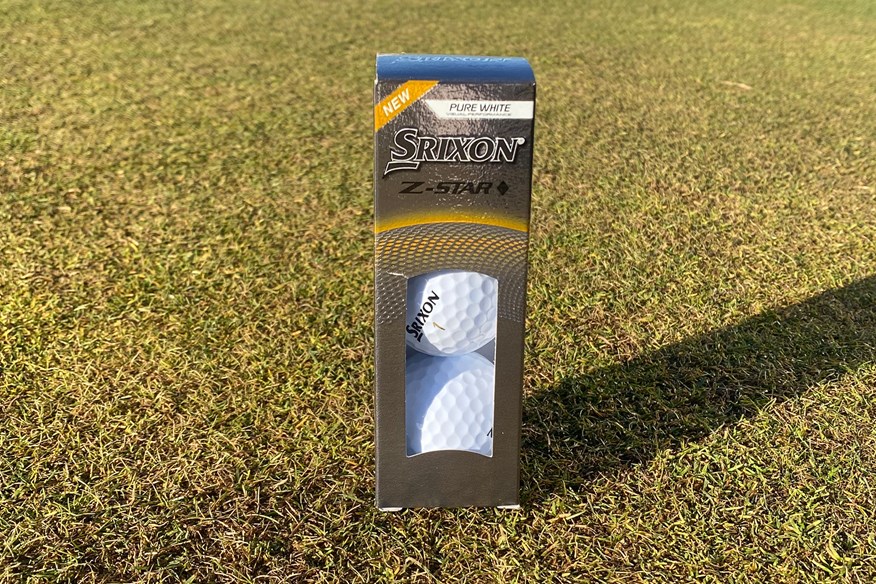
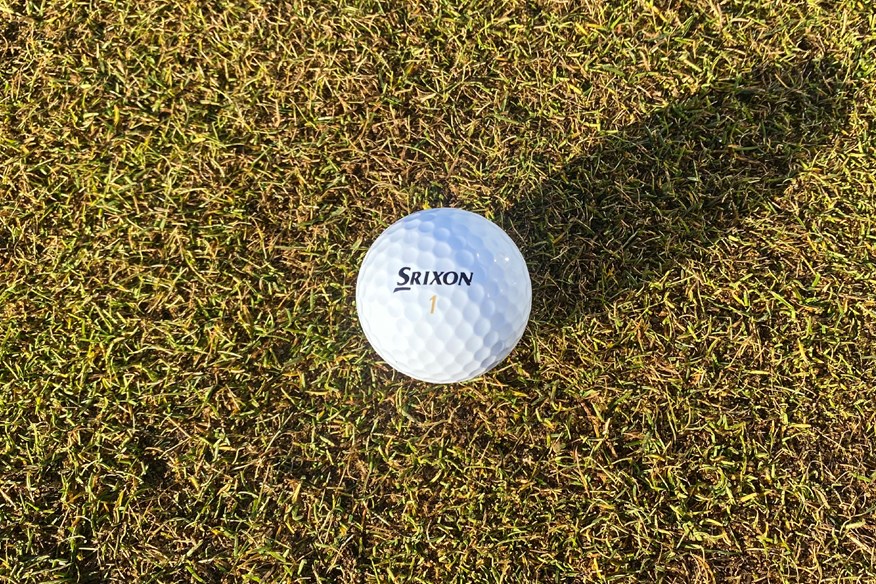
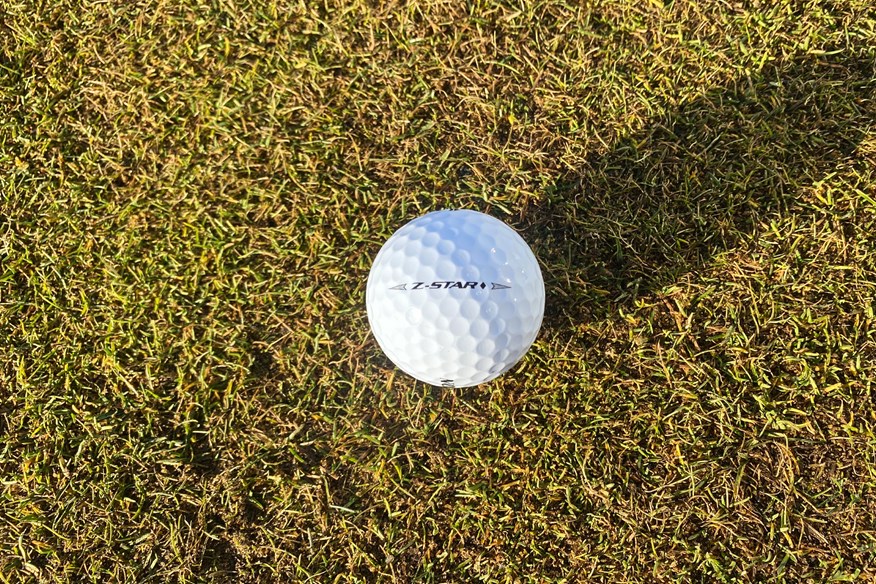
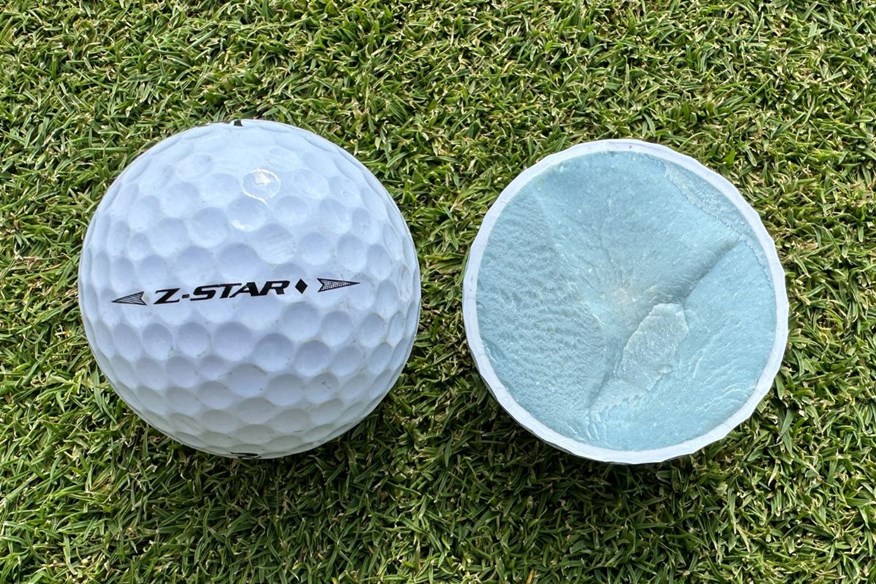
The Srixon Z-Star Diamond is one of the best high-spin golf balls. This golf ball was initially designed for Brooks Koepka, but it's become more popular among other Srixon staffers and amateur golfers. Based on our 2025 robot test results, it's clear to see why!
The Z-Star Diamond won an award in every category, barring one (off-the-tee performance), but where it did rank, it took the top spot. Let's have a quick run through the Z-Star Diamond's awards: gold medal for tee to green performance at 114mph, 93mph, and 78mph, gold medal for approach play, and gold medal for short-game performance.
Around the greens, the Z-Star Diamond is the best three-piece Tour-level golf ball you can play, and the second-best golf ball of all 62 tested, generating 6,137rpm at the 40-yard pitch shot.
However, it's unlikely you'll miss the green in the first place! The Z-Star Diamond is the best golf ball for firing at pins. This golf ball ranks second for descent angle (45.3°), fourth for carry distance consistency, and third for backspin (5,149rpm - one of only three golf balls with over 5,000rpm). This is a recipe for success when you're attacking pins.
The Z-Star Diamond is a consistent golf ball off the tee at all three driver swing speeds. So, whether you swing like Koepka or not, this golf ball will deliver strong numbers for your swing speed. The Z-Star Diamond is above the test average for ball speed and carry distance at all three driver swing speeds.
This golf ball cleaned up in the three-piece Tour-level category! The Z-Star Diamond has to be on your mind if you're looking for a new golf ball.
On-course verdict
The Srixon Z-Star Diamond delivers the optimal performance out of the three golf balls in the 2025 Z-Star range.
The Z-Star Diamond is brilliant if you’re looking for one of the best high-spin golf balls because it’s very easy to generate spin with this model. That being said, it’s definitely lower-spinning off the tee than the previous generation.
I’ve tested a heap of outstanding Tour-level golf balls over the past couple of years, but I don’t think any have impressed me as much as the Z-Star Diamond on approach shots.
If you think a golf ball that travels far and spins high sounds right for your game, then you have to try the Z-Star Diamond, regardless of your ability.
I absolutely love how this golf ball feels off every club face in my bag. I wouldn’t necessarily say it’s particularly firmer than the Z-Star or Z-Star XV, but I think the feedback is much stronger. Thanks to the solid feedback, the response is very satisfying on well-struck shots, but not so much when the contact isn’t as good. However, I think that’s what makes a good golf ball.
Of all the golf balls I’ve played with over the past couple of seasons, this is without a doubt the best-performing golf ball from tee to green.
The Z-Star Diamond performs optimally in every area, which makes it extremely difficult to criticise. It feels great, feedback is amazing, and performance is extraordinary.
I don’t know what more a golf ball can offer!
Read our full Srixon Z-Star Diamond golf ball review.
Pros
- Amazing control from tee to green
- High spinning in the iron and short game
- Fantastic feedback and response
Cons
- High-spinning nature does slightly hinder distance
| Carry distance (yds) | Driver 114mph - 270.7 | Driver 93mph - 207.8 | Driver 78mph - 161 | 7-iron - 153.1 |
| Ball speed (mph) | Driver 114mph - 163.6 | Driver 93mph - 133.8 | Driver 78mph - 113.1 | 7-iron - 108.7 |
| Backspin (rpm) | Driver 114mph - 2,988 | Driver 93mph - 2,838 | Driver 78mph - 2,719 | 7-iron - 5,149 | Pitch - 6,137 |
| Launch angle (°) | Driver 114mph - 11.2 | Driver 93mph - 12.5 | Driver 78mph - 13.6 | 7-iron - 20.5 | Pitch - 30 |
| Descent angle (°) | Driver 114mph - 39.4 | Driver 93mph - 32.6 | Driver 78mph - 28.1 | 7-iron - 45.3 | Pitch - 35.1 |
| Peak height (yds) | Driver 114mph - 34.5 | Driver 93mph - 22.4 | Driver 78mph - 15.7 | 7-iron - 29.3 | Pitch - 6.5 |
| Compression (psi) | 106 |
- Speed dimple pattern
- Thin premium Biomass cover
- Spin skin+ coating
- Fastlayer DG core 2.0
- 338 dimples
- 3-Piece construction
- Available in white and yellow
Bronze medal for tee to green performance at 78mph
The Seed SD-02 is the best-performing DTC golf ball off the tee. The SD-02 is designed to compete with the likes of the Titleist Pro V1x and TaylorMade TP5x, and that's exactly where it pitches based on the results from our test.
You can even argue it's a better-performing golf ball. At 78mph, the SD-02 is the third-best golf ball from tee to green, and at 93mph and 114mph, it misses out by one, finishing just behind the Pro V1x at 114mph and with the same score as the Staff Model at 93mph.
The SD-02 is such a solid golf ball from tee to green. At all three driver speeds, and with the approach shot, there isn't one area where it doesn't perform well.
Seed says this is a low-launching and low-flying golf ball, but if anything, it is above the average for launch angle and peak height in this category of golf balls.
This is supposedly Seed's highest-spinning golf ball around the green, but it's not as high-spinning as the SD-01. The SD-02 is also not as high-spinning in approach play as other Seed golf balls, and it's the lowest-spinning golf ball within this category (4,397rpm).
However, thanks to the steep descent angle, you can expect the SD-02 to hit and hold greens and come to a quick stop in the short game.
The Seed SD-02 is a solid golf ball from tee to green at varying swing speeds. It's not as high-spinning as other golf balls in this category or other Seed golf balls, but considering this is said to challenge the Pro V1x and TP5x, it does do that, at a cheaper price.
On-course verdict
I genuinely believe that any golfer could play with this golf ball and make it work for them. The SD-02 does it all. It’s long off the tee, it spins on approach shots, and it rolls perfectly on the putting surface.
The ball flight is consistent above all else, so I feel like I can trust that this golf ball will behave off the tee and help me find the fairway. The other plus off the tee is that it’s long, which no golfer can complain about.
The SD-02 feels slightly softer than other X-model golf balls, which will please most golfers because typically X-models tend to be firmer-feeling. I’m a fan of a firmer golf ball, and the SD-02 still feels really good to me.
Throughout the bag, the response you get from the SD-02 is very strong. If you hit the ball well, you’ll know, and if you hit the ball badly (sadly), you’ll know.
Read our full Seed SD-02 golf ball review.
Pros
- Amazing versatile golf ball that works for a wide range of golfers
- Good distance off the tee
- Incredible value for money
Cons
- A lower ball flight compared to other X-model golf balls
| Carry distance (yds) | Driver 114mph - 272.8 | Driver 93mph - 209.7 | Driver 78mph - 162.4 | 7-iron - 158.7 |
| Ball speed (mph) | Driver 114mph - 163.8 | Driver 93mph - 134.2 | Driver 78mph - 113.4 | 7-iron - 109.5 |
| Backspin (rpm) | Driver 114mph - 2,688 | Driver 93mph - 2,718 | Driver 78mph - 2,484 | 7-iron - 4,397 | Pitch - 5,845 |
| Launch angle (°) | Driver 114mph - 11 | Driver 93mph - 12.8 | Driver 78mph - 14 | 7-iron - 21.3 | Pitch - 30.9 |
| Descent angle (°) | Driver 114mph - 37 | Driver 93mph - 32.5 | Driver 78mph - 27.8 | 7-iron - 45 | Pitch - 36.4 |
| Peak height (yds) | Driver 114mph - 32.1 | Driver 93mph - 22.7 | Driver 78mph - 15.9 | 7-iron - 30 | Pitch - 7 |
| Compression (psi) | 104 |
- High energy rubber core
- Ultra thin DuPont Surlyn mantle
- DuPont HPF inner cover
- Soft cast urethane cover
- 336 dimples
- 4-Piece construction
- Available in white only
Gold medal for driver performance
Longest golf ball for average swing speeds
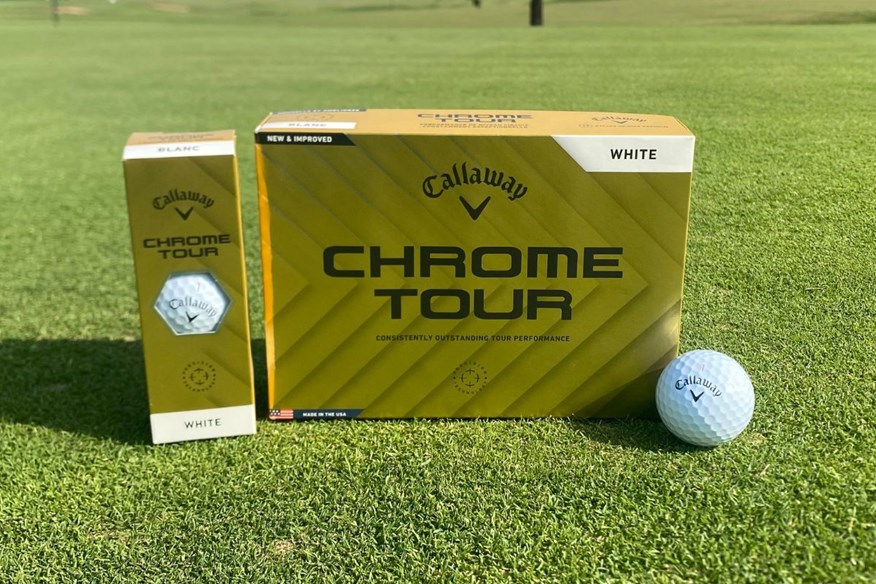

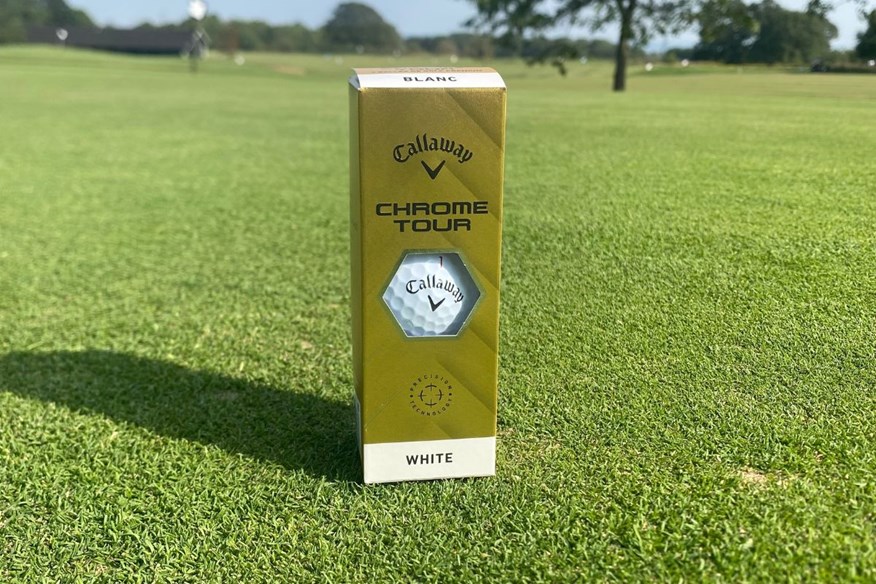
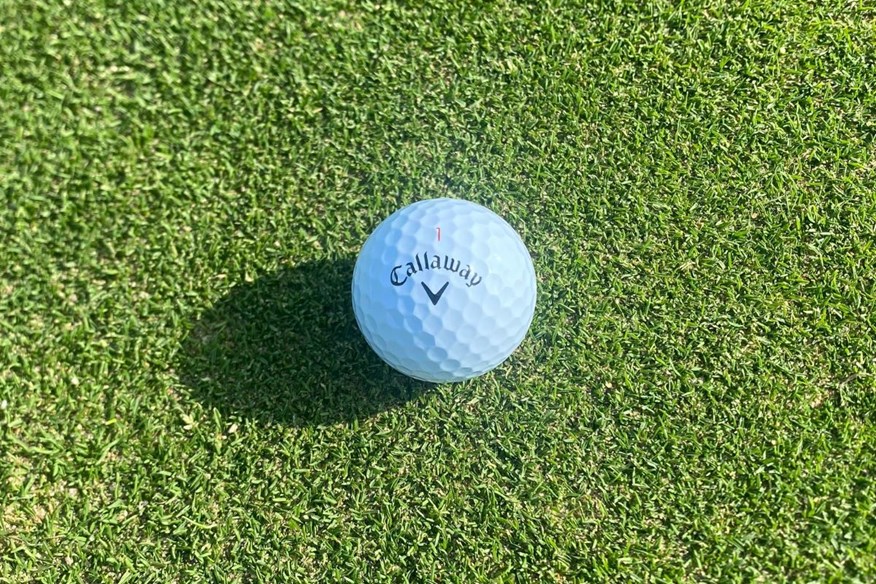

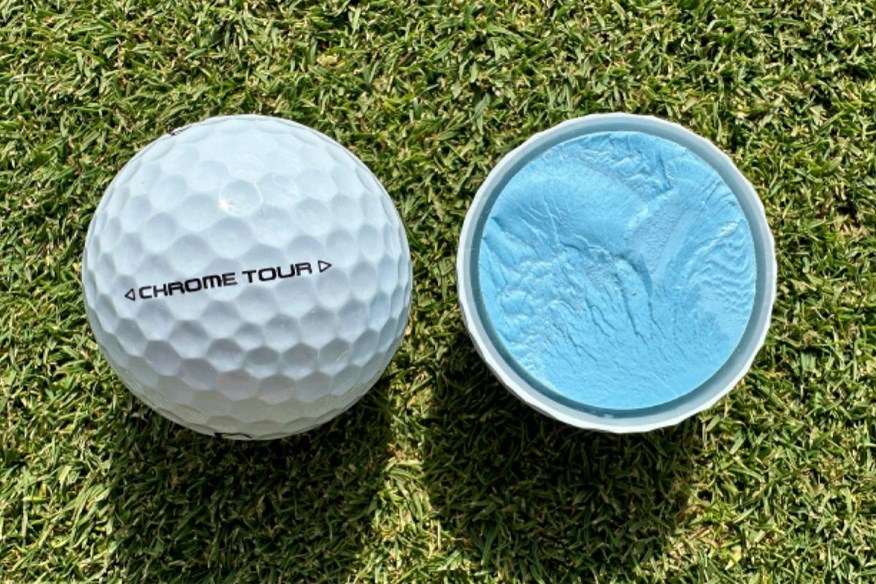
If you're looking to improve your tee game, the Callaway Chrome Tour is the ball you should choose out of all four-piece and five-piece golf balls.
At 114mph, the Callaway Chrome Tour is the fastest and longest golf ball of the entire test, being the only golf ball out of all 62 to exceed 275 carry yards. It's a similar story at 93mph, being the longest golf ball off the tee of all 62 tested.
Chrome Tour isn't as competitive with carry distance at slower swing speeds, but being lower spinning than other golf balls in this category helps to produce competitive total distance. Also, ball speed is joint-third fastest.
Where the Chrome Tour is low spinning off the tee, it's not the case approaching or playing around greens.
Chrome Tour is the complete package, and definitely a golf ball you have to consider if you want a premium, Tour-level golf ball that's fast and long off the tee, with good iron game and short game spin and control.
On-course verdict
I've had a lot of enjoyment playing with the Chrome Tour, most notably when I took this model out for a spin on The Old Course at St. Andrews. It's extremely difficult to find a negative considering it's long off the tee, high-spinning around the greens, and feels amazing.
This isn't a soft-feeling golf ball, but it's not firm either, it's somewhere in the middle, which is very pleasant because it offers great feedback as well as amazing feel.
The Chrome Tour is very strong off the tee, and it is noticeably longer than the Chrome Tour X on the course because it's not as high-spinning. The Chrome Tour is extremely popular on Tour, and it's clear to see why.
The Chrome Tour and Tour X are very closely matched, but the Chrome Tour is probably more versatile; it's just not as high-spinning when approaching and playing around greens.
Read our full Callaway Chrome Tour golf ball review.
Pros
- Impressive distance and ball speed
- Played by some of the best golfers in the game
- Very consistent golf balls
Cons
- Not as high-spinning as the Chrome Tour X
| Carry distance (yds) | Driver 114mph - 275.4 | Driver 93mph - 210.8 | Driver 78mph - 161.8 | 7-iron - 155.6 |
| Ball speed (mph) | Driver 114mph - 165.1 | Driver 93mph - 134.7 | Driver 78mph - 113.4 | 7-iron - 108.7 |
| Backspin (rpm) | Driver 114mph - 2,689 | Driver 93mph - 2,701 | Driver 78mph - 2,508 | 7-iron - 4,658 | Pitch - 6,036 |
| Launch angle (°) | Driver 114mph - 11 | Driver 93mph - 12.7 | Driver 78mph - 13.9 | 7-iron - 20.9 | Pitch - 30.1 |
| Descent angle (°) | Driver 114mph - 37.3 | Driver 93mph - 32.5 | Driver 78mph - 27.6 | 7-iron - 44.9 | Pitch - 35.2 |
| Peak height (yds) | Driver 114mph - 32.6 | Driver 93mph - 22.7 | Driver 78mph - 15.7 | 7-iron - 29.4 | Pitch - 6.5 |
| Compression (psi) | 113 |
- Hyper fast soft core
- Seamless Tour aero
- High-performance Tour urethane soft cover
- 332 dimples
- 4-Piece construction
- Available in white and yellow
- Alternative models include Triple Track, 360° Triple Track, TruTrack, and Limited Edition patterns
Vice's fastest and longest golf ball
The Vice Pro Plus is one of four golf balls in this category that didn't receive an award, but don't let that put you off. That's largely due to its tee performance. While this is the fastest and longest Vice golf ball, it's not overly competitive against other four-piece and five-piece golf balls.
At 114mph, Pro Plus is the third-lowest performing golf ball, the lowest performing at 93mph, and the third-lowest performing at 78mph. However, for approach play and short game performance, the Pro Plus does improve.
The backspin generated by the Pro Plus with the 7-iron shot is the third-highest within this category (4,807rpm), and the descent angle is 45.1°. The Pro Plus finished just outside the podium places for approach play performance.
It's the same story for short game performance. With 6,090rpm, Pro Plus finished fourth for short game performance by one revolution.
With the Vice Pro Plus, you might not have the most competitive golf ball off the tee, but from the fairway and around the greens, you can expect a golf ball that'll spin easily and is easy to control.
On-course verdict
This is the only golf ball in Vice's Pro range I recommend. That might sound harsh, considering the Pro is one of the best three-piece Tour-level golf balls, but in my on-course experience, I've not seen enough from the Pro that would make me recommend it over the Pro Plus.
This golf ball loses absolutely zero marks for distance, and as a whole, off the tee, I really couldn’t criticise the Pro Plus (except for one thing, which I’ll come to later). My main gripe is its performance around the greens; I just don’t feel as though it spins enough compared to other X-model golf balls.
It could be down to my chipping action, but I definitely find my joy around the greens with other golf balls when it comes to spin and control. Approaching greens, I feel very much the same as I do with regards to this golf ball’s performance off the tee.
Throughout the bag, I get very little feedback from any strike, whether it be good or bad. I distinctly remember hitting a really good tee shot on the 8th hole on the Ailsa Course at Turnberry and saying that it felt “dead”. When you really nail a drive, you want to be saying “that felt amazing,” but it left me feeling underwhelmed.
On the putting green, I feel as though there are more responsive golf balls than the Pro Plus, but you can’t argue with the roll, because it’s solid.
Ultimately, my overarching opinion on the feel and response of the Pro Plus is – as I’ve already mentioned – underwhelming.
Read our full Vice Pro Plus golf ball review.
Pros
- Solid performance from tee to green
- Brilliant value for a premium product
- A versatile model that works for ranging swing speeds
Cons
- A slightly muted feeling and limited feedback
| Carry distance (yds) | Driver 114mph - 271.9 | Driver 93mph - 208.2 | Driver 78mph - 160.5 | 7-iron - 155.2 |
| Ball speed (mph) | Driver 114mph - 163.6 | Driver 93mph - 133.7 | Driver 78mph - 114.3 | 7-iron - 112.9 |
| Backspin (rpm) | Driver 114mph - 2,780 | Driver 93mph - 2,848 | Driver 78mph - 2,643 | 7-iron - 4,807 | Pitch - 6,090 |
| Launch angle (°) | Driver 114mph - 10.9 | Driver 93mph - 12.7 | Driver 78mph - 13.7 | 7-iron - 20.8 | Pitch - 30.3 |
| Descent angle (°) | Driver 114mph - 37.4 | Driver 93mph - 33 | Driver 78mph - 27.8 | 7-iron - 45.1 | Pitch - 35.4 |
| Peak height (yds) | Driver 114mph - 32.2 | Driver 93mph - 22.8 | Driver 78mph - 15.6 | 7-iron - 29.4 | Pitch - 6.6 |
| Compression (psi) | 116 |
- Ultra thin cast urethane cover
- Versatile magnesium ionomer outer mantle
- Surlyn grade inner mantle
- Lightweight speed core
- 336 dimples
- 4-Piece construction
- Available in white and lime
- Alternative models include Drip, Shade, and Tracer
Bronze medal for off-the-tee performance
Fastest golf ball for average swing speeds
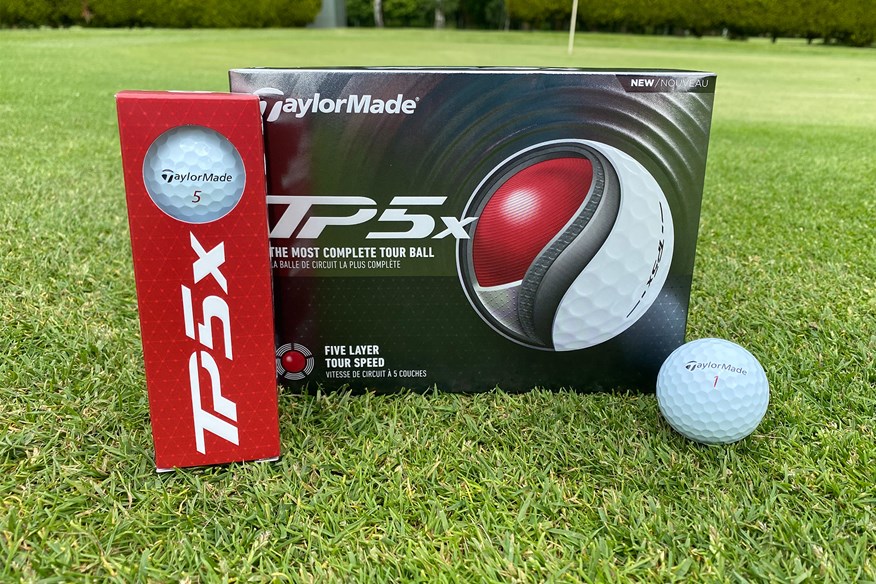

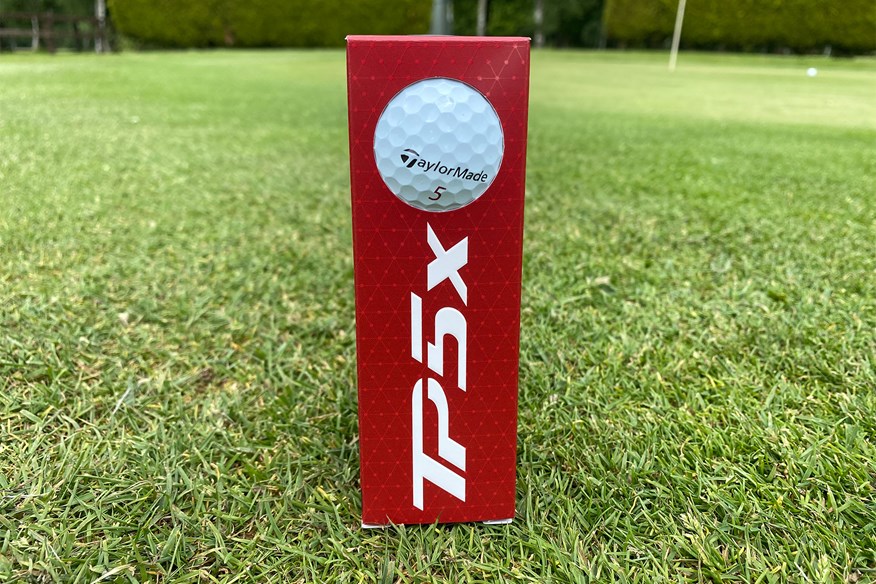
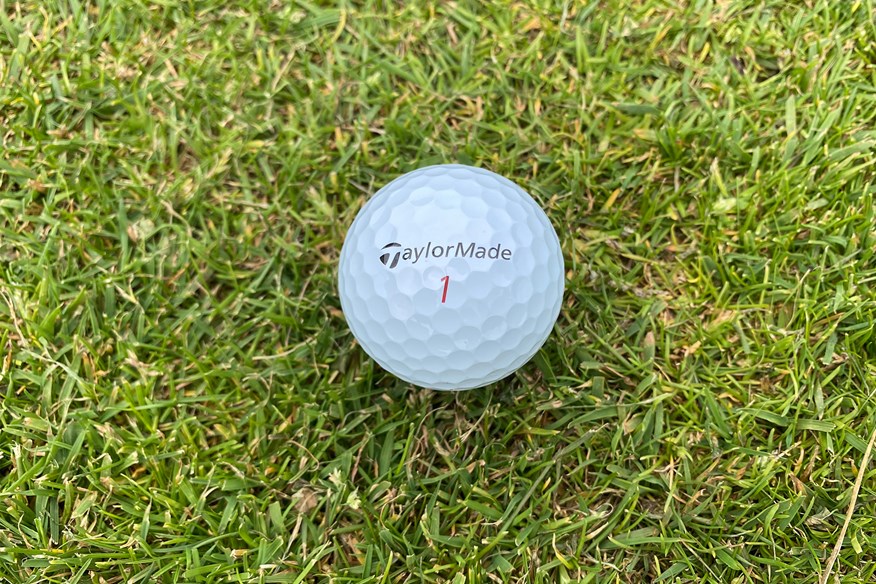
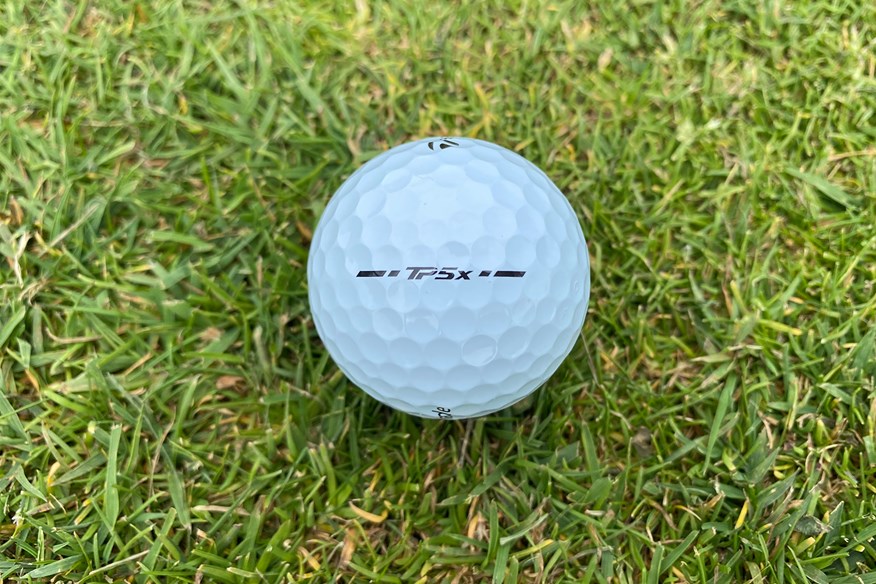
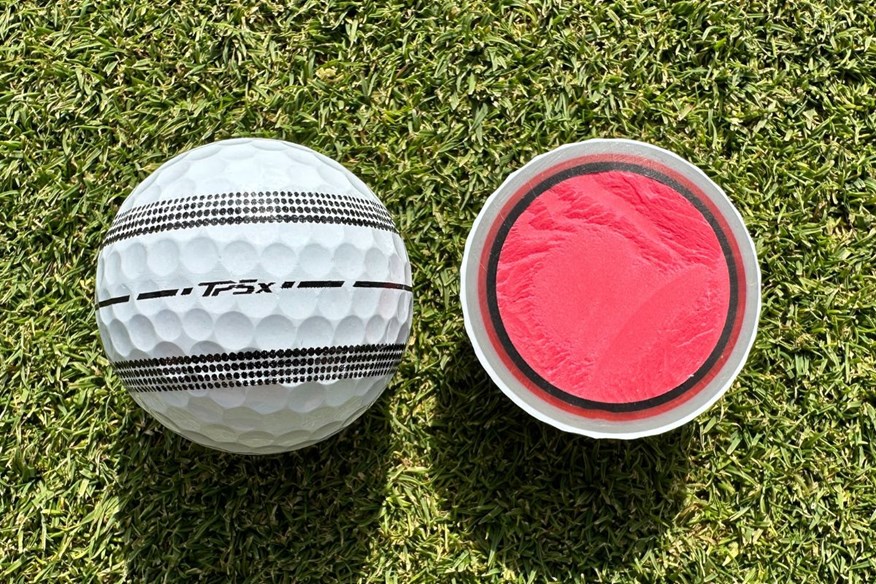
The TaylorMade TP5x steps up into a league of its own off the tee at the 78mph driver swing speed. It's a yard longer than the second-best performing golf ball and 0.4mph faster. At 93mph, TP5x is strong once again, being the fastest golf ball and the second longest.
Off-the-tee performance of the TP5x at both swing speeds is impressive, and it helps it achieve the bronze medal for off-the-tee performance. At 114mph, there is a drop-off in performance, but not enough to hinder the TP5x's overall score.
Approaching and playing around greens, the TP5x isn't as high-spinning as the TP5, but this model is sold as a low-spinning golf ball. With that in mind, it delivers a good amount of spin with the 7-iron (4,609rpm) and 40-yard pitch shots (6,042rpm).
TP5x delivers fast ball speeds, which makes it a very efficient golf ball. If you prioritise distance, the TP5x has to be in your thoughts, but not if you have a quick swing speed. If you're looking for more spin and control, I'd suggest looking at the TP5 instead.
On-course verdict
I'm very split between whether I prefer the firmer and more distance-oriented TP5x or the softer and higher-spinning TP5. If I'm being honest, my game benefits much more from a higher-spinning golf ball, so I think I have to side with Rory on this one and go for the TP5.
The reason I'm split is because I much prefer the firmer feel and response of the TP5x. I'm not particularly interested in the extra distance the TP5x offers because I'd much rather give up a couple of yards off the tee in exchange for putting the ball a couple of yards closer from the fairway.
The TP5x is well represented on Tour, despite a couple of players - including Rory - moving over to the TP5. It's clear to see why this five-piece golf ball is popular on Tour and in the amateur ranks, because it is solid from tee to green with an emphasis on eeking out a couple more yards.
I'm slightly in favour of the TP5, but if you ask me again in a couple of months, but opinion could well have changed.
Read our full TaylorMade TP5x golf ball review.
Pros
- High feedback and response
- Quality performance from tee to green
- Widely played on Tour
Cons
- Not as much short-game spin as the TP5
| Carry distance (yds) | Driver 114mph - 272.5 | Driver 93mph - 210.3 | Driver 78mph - 163.6 | 7-iron - 157.2 |
| Ball speed (mph) | Driver 114mph - 163.7 | Driver 93mph - 134.9 | Driver 78mph - 114.3 | 7-iron - 109.4 |
| Backspin (rpm) | Driver 114mph - 2,700 | Driver 93mph - 2,777 | Driver 78mph - 2,548 | 7-iron - 4,609 | Pitch - 6,042 |
| Launch angle (°) | Driver 114mph - 11 | Driver 93mph - 12.5 | Driver 78mph - 13.7 | 7-iron - 21.1 | Pitch - 29.9 |
| Descent angle (°) | Driver 114mph - 37.1 | Driver 93mph - 32.5 | Driver 78mph - 27.7 | 7-iron - 45.2 | Pitch - 35.1 |
| Peak height (yds) | Driver 114mph - 32.1 | Driver 93mph - 22.6 | Driver 78mph - 15.8 | 7-iron - 29.9 | Pitch - 6.6 |
| Compression (psi) | 117 |
- Speed-wrapped core
- Progressive 5-layer construction
- Seamless Tour flight dimple pattern
- 322 dimples
- 5-Piece construction
- Available in white only
- Alternative models include Pix, Stripe, and Limited Edition patterns
Gold medal for tee to green performance at all three driver swing speeds, off-the-tee performance, and approach play performance
Lowest-spinning golf ball for average swing speeds



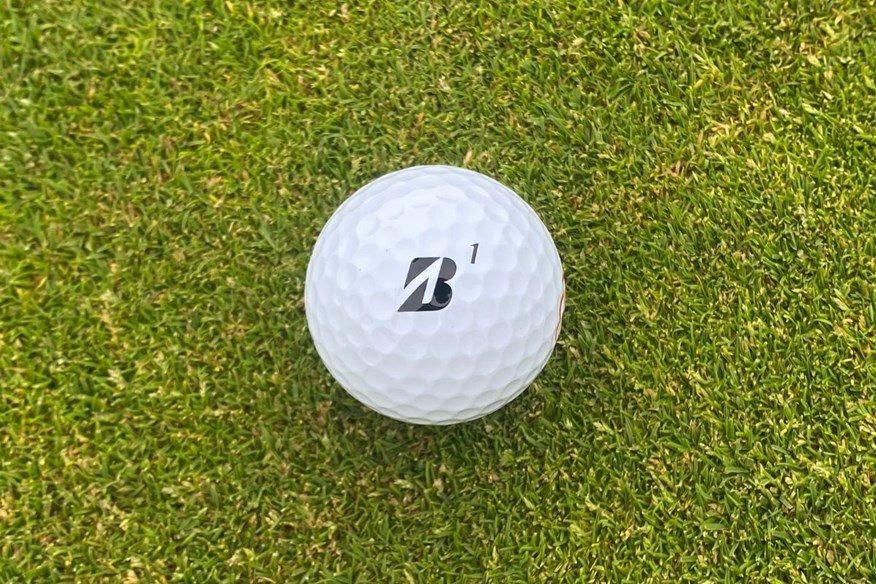
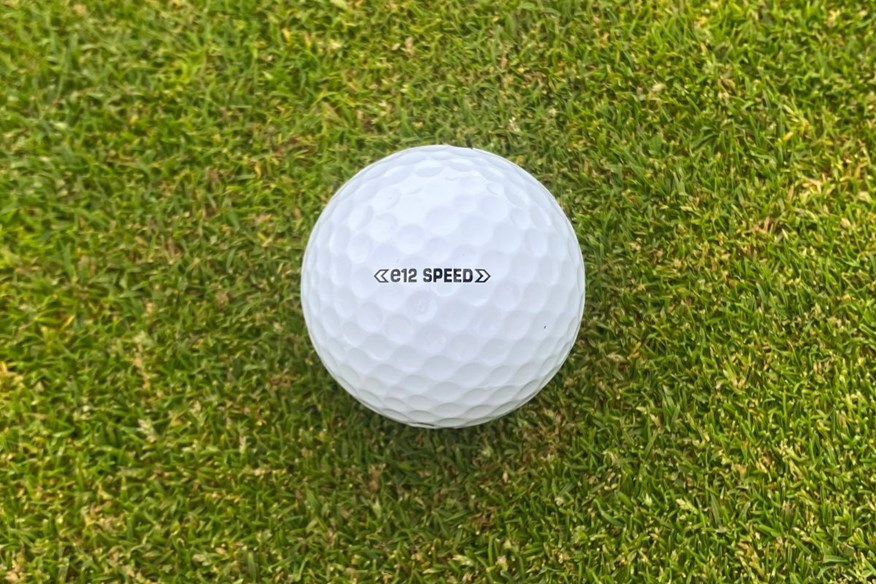
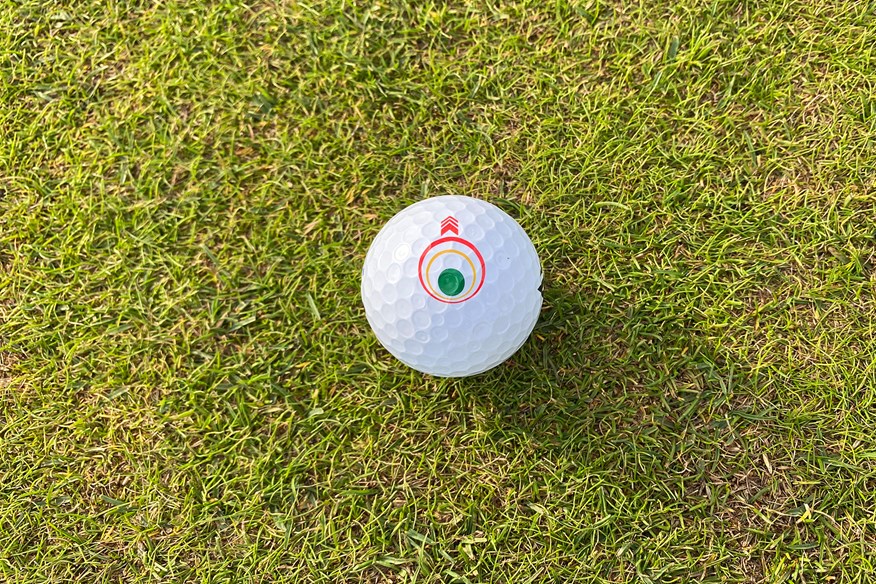

Let's start by running through all of the e12 Speed's awards. Gold medal for tee to green performance at 114mph, 93mph, and 78mph, off-the-tee performance, and approach play performance.
The only area where the e12 Speed didn't rank is short game performance, where it finished in fourth, by 9rpm (5,951).
The e12 Speed is the highest-performing Bridgestone golf ball, factoring in how it performed in every area. Its best performance has to be off the tee. At 114mph, this golf ball was 2.4 yards longer and 0.8mph faster than the second-longest and second-fastest model, and fourth-longest overall (273.9yds).
At 93mph, the e12 Speed is the second longest (209.7yds) and fastest (134.1mph) two-piece golf ball. But, at 78mph, this golf ball is back at the top of the table for both (161.3yds and 113.2mph).
Combine that performance with its dominating approach play performance, and not only do you have an amazing golf ball off the tee, but you have a fantastic golf ball from tee to green.
The e12 Speed is a golf ball I urge every golfer to consider. This is hands down the best value golf ball in the entire test, and as one of the best performers of all 62 models tested, what harm do you have in giving it a go?
On-course verdict
I was extremely surprised by the on-course performance of the Bridgestone e12 Speed, and having played with this golf ball on a couple of occasions, it has never disappointed.
The first time I played with the e12 Speed had me questioning if it definitely is a two-piece golf ball because it performs much closer to other three-piece Tour-level models.
The Bridgestone golf ball I' like most'm most fond of is the Tour B XS, and I think this performs very similarly - if not better.
The feel is slightly firmer than the Tour B XS, which is something I appreciate, and it does deliver more feedback and response throughout the bag.
Overall, I'm very impressed with the tee to green performance of the e12 Speed. Despite being a two-piece model, I wouldn't be quick to dismiss it.
Pros
- Perfroms more like a premium golf ball
- Outstanding tee to green performance
- Amazing feedback and response
Cons
- Very difficult to criticize
| Carry distance (yds) | Driver 114mph - 273.9 | Driver 93mph - 210 | Driver 78mph - 161.3 | 7-iron - 157.6 |
| Ball speed (mph) | Driver 114mph - 164 | Driver 93mph - 134.1 | Driver 78mph - 113.2 | 7-iron - 109.2 |
| Backspin (rpm) | Driver 114mph - 2,680 | Driver 93mph - 2,574 | Driver 78mph - 2,317 | 7-iron - 4,467 | Pitch - 5,951 |
| Launch angle (°) | Driver 114mph - 11.4 | Driver 93mph - 12.9 | Driver 78mph - 14.1 | 7-iron - 21.3 | Pitch - 30.7 |
| Descent angle (°) | Driver 114mph - 37.6 | Driver 93mph - 31.8 | Driver 78mph - 27 | 7-iron - 45.1 | Pitch - 36 |
| Peak height (yds) | Driver 114mph - 33 | Driver 93mph - 22.3 | Driver 78mph - 15.5 | 7-iron - 30 | Pitch - 6.9 |
| Compression (psi) | 103 |
- Optimal Flight System
- Fast gradational core
- MindSet technology
- 330 dimples
- 2-Piece construction
- Available in white only
Best golf balls for average swing speeds: Robot test data
View our full golf ball robot test results.
| Golf ball | Wilson Staff Model X | Callaway Chrome Tour X | Wilson Staff Model | Srixon Z-Star Diamond | Seed SD-02 | Callaway Chrome Tour | Vice Pro Plus | TaylorMade TP5x | Bridgestone e12 Speed |
| Compression | 114 | 111 | 112 | 106 | 104 | 113 | 116 | 117 | 103 |
| 93mph Driver Ball Speed (mph) | 134.6 | 134.3 | 134.0 | 133.8 | 134.2 | 134.7 | 133.7 | 134.9 | 134.1 |
| 93mph Driver Launch Angle (°) | 12.5 | 12.5 | 12.8 | 12.5 | 12.8 | 12.7 | 12.7 | 12.5 | 12.9 |
| 93mph Driver Backspin (rpm) | 2792 | 3048 | 2703 | 2838 | 2718 | 2701 | 2848 | 2777 | 2574 |
| 93mph Driver Carry Distance (yds) | 209.8 | 208.9 | 209.2 | 207.8 | 209.7 | 210.8 | 208.2 | 210.3 | 209.7 |
| 93mph Driver Height (yds) | 22.6 | 23.4 | 22.5 | 22.4 | 22.7 | 22.7 | 22.8 | 22.6 | 22.3 |
| 93mph Driver Descent Angle (°) | 32.6 | 34.0 | 32.4 | 32.6 | 32.5 | 32.5 | 33.0 | 32.5 | 31.8 |
| 7-Iron Ball Speed (mph) | 109.3 | 108.7 | 109.0 | 108.7 | 109.5 | 108.7 | 108.9 | 109.4 | 109.2 |
| 7-Iron Launch Angle (°) | 21.0 | 20.3 | 21.1 | 20.5 | 21.3 | 20.9 | 20.8 | 21.1 | 21.3 |
| 7-Iron Backspin (rpm) | 4782 | 5242 | 4653 | 5149 | 4397 | 4658 | 4807 | 4609 | 4467 |
| 7-Iron Carry Distance (yds) | 156.1 | 152.5 | 156.3 | 153.1 | 158.7 | 155.6 | 155.2 | 157.2 | 157.6 |
| 7-Iron Height (yds) | 30.0 | 29.1 | 29.8 | 29.3 | 30.0 | 29.4 | 29.4 | 29.9 | 30.0 |
| 7-Iron Descent Angle (°) | 45.4 | 45.3 | 45.2 | 45.3 | 45.0 | 44.9 | 45.1 | 45.2 | 45.1 |
| 40-Yard Pitch Ball Speed (mph) | 46.3 | 46.2 | 46.4 | 46.3 | 46.6 | 45.9 | 46.1 | 46.3 | 46.4 |
| 40-Yard Pitch Launch Angle (°) | 30.4 | 29.5 | 30.6 | 30.0 | 30.9 | 30.1 | 30.3 | 29.9 | 30.7 |
| 40-Yard Pitch Backspin (rpm) | 6091 | 6343 | 5993 | 6137 | 5845 | 6036 | 6090 | 6042 | 5951 |
| 40-Yard Pitch Carry Distance (yds) | 39.6 | 38.8 | 39.8 | 39.3 | 40.3 | 38.8 | 39.2 | 39.3 | 39.8 |
| 40-Yard Pitch Height (yds) | 6.7 | 6.3 | 6.8 | 6.5 | 7.0 | 6.5 | 6.6 | 6.6 | 6.9 |
| 40-Yard Pitch Descent Angle (°) | 35.5 | 34.4 | 35.8 | 35.1 | 36.4 | 35.2 | 35.4 | 35.1 | 36.0 |
Best golf balls for average swing speeds 2025: Buying guide
On the surface, purchasing a golf ball based on your swing speed sounds incredibly straightforward, but sadly, it might not be as simple as it sounds.
Whether you’re looking to increase spin, reduce spin, add distance, or improve consistency, there are many subtle differences to consider with all of the best golf balls for average swing speeds.
Depending on your needs and requirements from a golf ball, reading through our detailed buying guide will hopefully provide you with some clarity as to which model will work best for you.
Ability
Ability won’t come into play as much as it does if you’re solely looking for a golf ball that works with your swing speed. What I mean by this is, you could be playing off 24 or 2.4, and if you have an average swing speed, then you’re better off playing with a golf ball designed to deliver performance for your swing speed than one chosen purely on ability.
That being said, you can still pick a golf ball for average swing speeds based on your ability if you wish. Among the best golf balls for average swing speeds, there are some of the best premium golf balls and best value options. No matter how much money you like to spend on golf balls, there’s plenty of choice in this category.
Budget
Whether your budget is £30 or £50, you’ll be able to play with one of the best golf balls for average swing speeds.
Naturally, the tighter your budget, the fewer performance benefits you’ll unlock. For instance, if you choose a more affordable distance ball, you’ll potentially sacrifice some short-game spin and precision compared to a premium Tour ball like the Wilson Staff Model X or Callaway Chrome Tour X, which are designed to deliver consistency from tee to green.
Therefore, if you can, I would strongly suggest budgeting tighter elsewhere and investing more in golf balls.
What counts as an average swing speed?
“Average” is a very broad measurement, but in golf ball terms, an average swing speed generally means 85-105mph with the driver. Within this bracket, you’ll find many female Tour players and amateur golfers.
Performance
Determining whether you need a golf ball for average swing speeds wholly depends on how quickly you swing the club. The best way to find out your swing speed is by hitting shots on a trusted launch monitor that you know will give you accurate numbers.
The beauty of working solely with swing speed data is that it’s objective. Once you know your driver swing speed, you can match it to the golf balls that are designed to perform at that speed.
Feel
Feel is for many golfers a non-negotiable. The majority of golfers prefer playing with a soft-feeling golf ball, though some may lean towards a firmer feel for added feedback.
There’s a real mix of soft and firmer golf balls that are suitable for golfers with an average swing speed. For example, even firmer-feeling Tour models like the Wilson Staff Model X is still far softer than the rock-like balls of years gone by.
While feel is important, it shouldn’t outweigh performance. You might love the sensation of a soft ball, but if it spins too much or costs you distance at higher speeds, it’s not the right fit.
Spin
Some golf balls generate spin more easily than others, and their construction heavily influences this. Multi-layer premium golf balls are built to optimise spin at both ends, lower spin off the tee for distance, and higher spin around the greens for control.
Cheaper golf balls, often two-piece designs with Surlyn or ionomer covers, tend to produce less spin and may not give you the control you want. In contrast, urethane-covered Tour balls with four or five layers are engineered to manage spin intelligently, keeping driver spin down while providing bite on approach shots and around the greens.
Spin can be either your best friend or worst enemy. Choosing one of the best golf balls for average swing speeds will help you harness spin, not fight it.
Distance
My opinion is that distance is the least important factor to consider when choosing a golf ball.
The right golf ball will help optimise your launch and spin to maximise carry without ballooning or over-spinning. A ball that’s too soft or too low-compression for your swing could rob you of consistency, so getting this right is key.
Alignment
Many golf balls now come with enhanced alignment aids printed on them. Whether you swing fast or slow, alignment tools can help you set up more consistently. Brands are offering alignment designs in all shapes and sizes, and there’s no harm in experimenting to see if it helps your putting.
Colour
While most golfers still reach for the classic white golf ball, plenty of golf balls for average swing speeds are available in multiple colours. Whether you prefer yellow, high-visibility orange, or something more subtle, the choice is there.
Coloured golf balls make for some of the best winter golf balls due to their visibility, and it’s worth remembering they’re exactly the same golf ball as the white version. No one likes losing a ball unnecessarily, so pick the colour you can see best and save yourself shots and cash.
Best golf balls for average swing speeds: FAQs
What to read next
For performance insights tailored to your swing speed and preferences, head to our results hubs:
- Best 4 and 5-piece golf balls
- Best 3-piece golf balls
- Best 2-piece golf balls
- Best golf balls for fast swing speeds
- Best golf balls for slow swing speeds
- Best golf balls for distance
- Best golf balls for approach play
- Best golf balls for short game
- Best golf ball for mid-handicaps
- Best golf balls for beginners
- Most consistent golf balls
